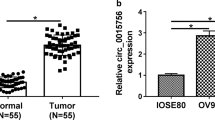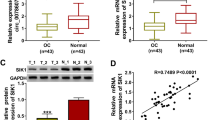Abstract
Previous studies have suggested that circular RNAs (circRNAs) play important regulatory roles in cancer progression. Previous evidence exhibited the aberrant upregulation of circ_0061140 in ovarian cancer. However, the detailed role of circ_0061140 in ovarian cancer progression and its associated mechanism remain largely unknown and need further exploration. The expression of circ_0061140, microRNA-761 (miR-761) and leucine zipper and EF-hand containing transmembrane protein 1 (LETM1) was checked by reverse transcription-quantitative polymerase chain reaction (RT-qPCR) or western blot. Cell Counting Kit-8 (CCK8), colony formation, 5-Ethynyl-2’-deoxyuridine (EdU), flow cytometry, wound healing, transwell, and tube formation assays were conducted to assess cell functions. Dual-luciferase reporter assay and RNA immunoprecipitation (RIP) assay were performed to confirm the interaction between miR-761 and circ_0061140 or LETM1. Xenograft tumor model was established to analyze the role of circ_0061140 in tumor growth in vivo. Circ_0061140 expression was notably up-regulated in ovarian cancer tissues and cell lines. Circ_0061140 knockdown suppressed the proliferation, migration, invasion, and angiogenesis and triggered the apoptosis of ovarian cancer cells. Circ_0061140 directly interacted with miR-761, and circ_0061140 silencing-mediated anti-tumor effects were partly abolished by miR-761 knockdown in ovarian cancer cells. LETM1 was a direct target of miR-761, and LETM1 overexpression partly counteracted miR-761-induced anti-tumor effects. Circ_0061140 could up-regulate LETM1 expression by sponging miR-761. Circ_0061140 knockdown significantly suppressed xenograft tumor growth in vivo. Circ_0061140 aggravated ovarian cancer progression through miR-761-dependent regulation of LETM1.









Similar content being viewed by others
Data Availability
The analyzed data sets generated during the present study are available from the corresponding author on reasonable request.
References
Ahmed I et al (2016) Altered expression pattern of circular RNAs in primary and metastatic sites of epithelial ovarian carcinoma. Oncotarget 7(24):36366–36381
Attar R et al (2021) Overview of the signaling pathways involved in metastasis: An intriguing story-tale of the metastatic journey of ovarian cancer cells. Cell Mol Biol 67(3):212–223
Bonifacio VDB (2020) Ovarian cancer biomarkers: moving forward in early detection. Adv Exp Med Biol 1219:355–363
Chen B, Huang S (2018) Circular RNA: An emerging non-coding RNA as a regulator and biomarker in cancer. Cancer Lett 418:41–50
Chen LL, Yang L (2015) Regulation of circRNA biogenesis. RNA Biol 12(4):381–388
Chen Q et al (2021) CircWHSC1 promotes breast cancer progression by regulating the FASN/AMPK/mTOR axis through sponging miR-195-5p. Front Oncol 11:649242
Du Z, Wang L, Xia Y (2020) Circ_0015756 promotes the progression of ovarian cancer by regulating miR-942-5p/CUL4B pathway. Cancer Cell Int 20(1):572
Fabian MR, Sonenberg N, Filipowicz W (2010) Regulation of mRNA translation and stability by microRNAs. Annu Rev Biochem 79:351–379
Feng Y et al (2019) Does circular RNA exert significant effects in ovarian cancer? Crit Rev Eukaryot Gene Expr 29(2):161–170
Hansen TB et al (2013) Natural RNA circles function as efficient microRNA sponges. Nature 495(7441):384–388
Hou W, Zhang Y (2021) Circ_0025033 promotes the progression of ovarian cancer by activating the expression of LSM4 via targeting miR-184. Pathol Res Pract 217:153275
Hsiao KY, Sun HS, Tsai SJ (2017) Circular RNA - New member of noncoding RNA with novel functions. Exp Biol Med (maywood) 242(11):1136–1141
Integrated genomic analyses of ovarian carcinoma (2011) Nature 474(7353):609–615
Jayson GC et al (2014) Ovarian cancer. Lancet 384(9951):1376–1388
Kristensen LS et al (2019) The biogenesis, biology and characterization of circular RNAs. Nat Rev Genet 20(11):675–691
Li J, Xie R (2019) Circular RNA expression profile in gingival tissues identifies circ_0062491 and circ_0095812 as potential treatment targets. J Cell Biochem 120(9):14867–14874
Li N et al (2015) LETM1 overexpression is correlated with the clinical features and survival outcome of breast cancer. Int J Clin Exp Pathol 8(10):12893–12900
Li H et al (2020) LETM1 is a potential biomarker that predicts poor prognosis in gastric adenocarcinoma. Exp Mol Pathol 112:104333
Li Y et al (2020) miR-409–3p inhibits the proliferation and migration of human ovarian cancer cells by targeting Rab10. Cell Mol Biol 66(7):197–201
Livak KJ, Schmittgen TD (2001) Analysis of relative gene expression data using real-time quantitative PCR and the 2(-Delta Delta C(T)) Method. Methods 25(4):402–408
Longuespée R et al (2012) Ovarian cancer molecular pathology. Cancer Metastasis Rev 31(3–4):713–732
Piao L et al (2019) LETM1 is a potential cancer stem-like cell marker and predicts poor prognosis in colorectal adenocarcinoma. Pathol Res Pract 215(7):152437
Rong D et al (2017) An emerging function of circRNA-miRNAs-mRNA axis in human diseases. Oncotarget 8(42):73271–73281
Sheng R et al (2020) Circular RNAs and their emerging roles as diagnostic and prognostic biomarkers in ovarian cancer. Cancer Lett 473:139–147
Shi C, Zhang Z (2016) miR-761 inhibits tumor progression by targeting MSI1 in ovarian carcinoma. Tumour Biol 37(4):5437–5443
Shibuya M (2011) Vascular endothelial growth factor (VEGF) and Its receptor (VEGFR) signaling in angiogenesis: a crucial target for anti- and pro-angiogenic therapies. Genes Cancer 2(12):1097–1105
Tabassam Q et al (2021) Phytochemical investigation and effective therapeutic potential of plants extracts against breast and ovarian cancer cell lines: compounds from zizyphus mauritiana and triticum aestivum. Cell Mol Biol 67(1):147–152
Tai YL et al (2018) Exosomes in cancer development and clinical applications. Cancer Sci 109(8):2364–2374
Wang J et al (2020) Long non-coding RNA RHPN1-AS1 promotes tumorigenesis and metastasis of ovarian cancer by acting as a ceRNA against miR-596 and upregulating LETM1. Aging (albany NY) 12(5):4558–4572
Wei S, Qi L, Wang L (2021) Overexpression of circ_CELSR1 facilitates paclitaxel resistance of ovarian cancer by regulating miR-149-5p/SIK2 axis. Anticancer Drugs 32(5):496–507
Wu X et al (2021) Circ_0007444 inhibits the progression of ovarian cancer via mediating the miR-570-3p/PTEN axis. Onco Targets Ther 14:97–110
Xiong W et al (2019) MiR-761 inhibits colorectal cancer cell proliferation and invasion through targeting HDAC1. Pharmazie 74(2):111–114
Yang H et al (2020) CircPTK2 (hsa_circ_0005273) as a novel therapeutic target for metastatic colorectal cancer. Mol Cancer 19(1):13
Yang Q, Fei Z, Huang C (2021) Betulin terpenoid targets OVCAR-3 human ovarian carcinoma cells by inducing mitochondrial mediated apoptosis, G2/M phase cell cycle arrest, inhibition of cell migration and invasion and modulating mTOR/PI3K/AKT signalling pathway. Cell Mol Biol 67(2):14–19
Yao X, Xie L, Zeng Y (2020) MiR-9 promotes angiogenesis via targeting on sphingosine-1- phosphate receptor 1. Front Cell Dev Biol 8:755
Zeng Y, Fu BM (2020) Resistance mechanisms of anti-angiogenic therapy and exosomes-mediated revascularization in cancer. Front Cell Dev Biol 8:610661
Zeng Y et al (2019) Anti-angiogenesis triggers exosomes release from endothelial cells to promote tumor vasculogenesis. J Extracell Vesicles 8(1):1629865
Zhang Q, Sui Y, Sui X (2019) MicroRNA-761 inhibits the metastasis of gastric cancer by negatively regulating Ras and Rab interactor 1. Oncol Lett 18(3):3097–3103
Acknowledgements
Not applicable.
Funding
No funding was received.
Author information
Authors and Affiliations
Corresponding author
Ethics declarations
Conflict of interest
The authors declare that they have no competing interests.
Ethical Approval
The clinical study was approved by the ethical review committee of The First affiliated Hospital of Xi’An Jiaotong University. All the participants had signed the written informed consent. The protocol in animal study was approved by the ethical review committee of The First affiliated Hospital of Xi’An Jiaotong University.
Consent for Publication
All the authors agree to publish this paper.
Additional information
Publisher's Note
Springer Nature remains neutral with regard to jurisdictional claims in published maps and institutional affiliations.
Supplementary Information
Below is the link to the electronic supplementary material.
10528_2022_10277_MOESM1_ESM.tif
Supplementary file1 Figure S1 Circ_0061140 overexpression enhanced ovarian cancer cell proliferation, migration, invasion and angiogenesis. (A-G) SKOV3 and A2780 cells overexpressing circ_0061140 were used in the following assays. (A and B) Cell proliferation was evaluated by CCK8 assay. (C and D) Cell proliferation was evaluated by colony formation assay and EdU assay. (E and F) Cell migration and invasion were evaluated by wound healing assay and transwell assay. (G) The ability of angiogenesis was assessed by tube formation assay. (H and I) The expressions of PCNA, Bax, and Bcl-2 proteins were assessed by western blot. **p<0.01, ***p<0.001, ****p<0.0001 (TIF 4755 kb)
10528_2022_10277_MOESM2_ESM.tif
Supplementary file2 Figure S2. MiR-761 expression increased most in ovarian cancer cells after circ_0061140 knockdown. (A and B) The expression of predicted miRNAs in SKOV3 and A2780 cells transfected with si-circ_0061140 or si-NC was examined using RT-qPCR. **p<0.01, ***p<0.001, ****p<0.0001 (TIF 336 kb)
10528_2022_10277_MOESM3_ESM.tif
Supplementary file3 Figure S3. LETM1 expression decreased most in ovarian cancer cells after miR-761 enrichment. (A and B) The expression of predicted mRNAs in SKOV3 and A2780 cells transfected with miR-761 mimic or miR-NC was examined using RT-qPCR. **p<0.01, ***p<0.001, ****p<0.0001 (TIF 301 kb)
Rights and permissions
Springer Nature or its licensor holds exclusive rights to this article under a publishing agreement with the author(s) or other rightsholder(s); author self-archiving of the accepted manuscript version of this article is solely governed by the terms of such publishing agreement and applicable law.
About this article
Cite this article
Ma, L., Liu, W. & Li, M. Circ_0061140 Contributes to Ovarian Cancer Progression by Targeting miR-761/LETM1 Signaling. Biochem Genet 61, 628–650 (2023). https://doi.org/10.1007/s10528-022-10277-6
Received:
Accepted:
Published:
Issue Date:
DOI: https://doi.org/10.1007/s10528-022-10277-6




